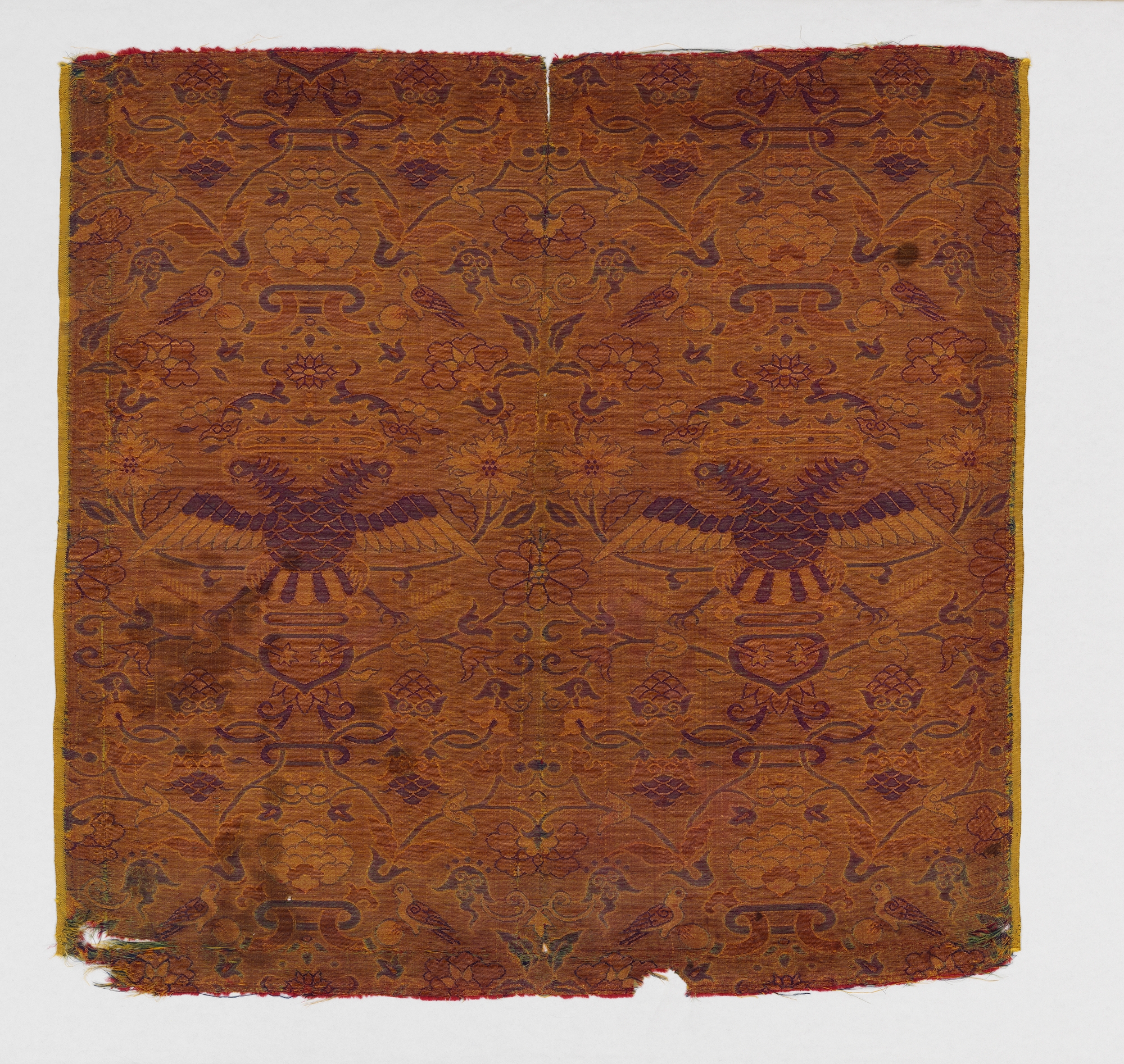Textile with crowned double headed eagles
Chinese, Macao, for Iberian market
Not on view
Crowned and splayed double-headed eagles, symbols of the Habsburg dynasty, are woven into this Chinese textile, one of a large group of related examples made for the Portuguese and Spanish market in the last part of the sixteenth century. The group represents an early production for export of complex woven silks that integrate both Iberian and Asian aesthetics and design. In this example, the eagle holds in its talons arrows that pierce a heart-shaped vase. The device of a heart pierced by arrows is associated with the Augustinian religious order, while representations of floral vases were popular motifs in China.
The conflation of pious and secular imagery seen here may be the result of free rein being given to the master weaver commissioned to produce the cloth. Although the pattern, colors, and general layout have a notable European character, a number of details point to an Asian hand in the design. The form of the oddly shaped leaf on the scrolling vines, for example, resembles Chinese floral patterns more than the European acanthus leaves we might expect to find, especially as associated with the grapelike fruit cluster motif that repeats throughout. Additionally, the stylized dark blue flowers are Chinese peonies; they alternate with the eagles, whose extended, erect neck feathers and patterned breasts recall the graphic means sometimes used by Chinese artisans to render the image of a phoenix. It could be that the weaver modified an original source (perhaps a European print) to incorporate these Asian elements within the overall European format.
A related group of silks, possibly from a different workshop, shares some of the design features seen here, including the arrow-holding double-headed eagles amid scrolling vines, although in that group the eagles are contained within narrow vertical panels delineated by leafy borders. Multiple examples of textiles with this design exist; in general, they have the same crimson red (lac dye) ground and are decorated in two colors, blue and yellow. In addition to silk, these fine woven textiles incorporate flat threads of gold leaf on paper, typical of East Asian works.¹ A complete cope (Royal Ontario Museum, Toronto) and a portion of a chasuble (Victoria and Albert Museum, London) made of this fabric confirm that it was used in Christian ecclesiastical vestments.² The exact location of production for this group of silks is unknown, but the combination of Iberian and Asian motifs and styles is typical of products exported through Macau, a major center of trade in the sixteenth century.
Although other Macau silks possess similar design elements, the color scheme of this example, with its pattern of green, blue, and yellow, is distinctive. It has been proposed, based on the motif of the arrow piercing the heart, that the fabric was made specifically for Augustinians active in the Philippines, but examples found in Spain, Portugal, and other European centers suggest it may have been part of the larger Iberian trade.
[Melinda Watt, adapted from Interwoven Globe, The Worldwide Textile Trade, 1500-1800/ edited by Amelia Peck; New York: Metropolitan Museum of Art; New Haven: distributed by Yale University Press, 2013]
Footnotes:
1. There are two examples in the Metropolitan's collection: acc. nos. 34.41.9 (red, blue, and yellow) and 34.41.1 (blue and yellow). The dyes used in this textile were analyzed by Nobuko Shibayama in the Department of Scientific Research, Metropolitan Museum, using High Performance Liquid Chromatography-Photo Diode Array (HPLC-PDA). The red color is lac dye, and the yellow is from the Asian pagoda tree (Sophora japonica). See also Digby, "Some Silks Woven under Portuguese Influence in the Far East," pp. 52-63.
2. For the Toronto silk (no. 973.422), see Vollmer, Keall, and Nagai-Berthrong, Silk Roads, China Ships, p. 19 and Mayer et al., Raiment for the Lord's Service, pp. 154-55. The London example (no. T215-1910) can be seen on the museum’s website, http://collections.vam.ac.uk/item/O486944/fragment-unknown/. (Additional examples in the Victoria and Albert Museum include nos. T.217-1910 and T.169-1929).
Due to rights restrictions, this image cannot be enlarged, viewed at full screen, or downloaded.
This artwork is meant to be viewed from right to left. Scroll left to view more.



